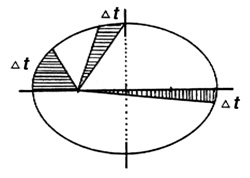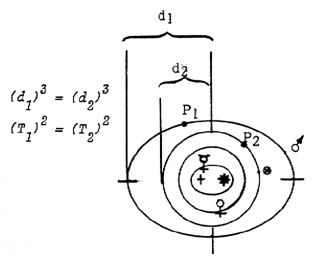1st Law (1609): Each planet (P) revolves around the Sun in an elliptical orbit, with the Sun at one focus of the ellipse.

2nd Law (1609): A radius vector from the Sun to any particular planet sweeps out equal areas in equal times. (The hatched-in areas are equal.)

3rd Law (1618): The squares of the periods of revolution (T1,T2) of the planets (P1,P2) are proportional to the cubes of their mean distances (d1,d2) from the Sun. (Note: the ‘mean distance’ of a planet from the Sun is the semi-major axis of its elliptical orbit.)

The Planetary Times (PT, in Earth Years) and Mean Distances from the Sun (MD, in Earth-Sun ratios) are given below along with the easily multiplied results. Notice the relationship between the Times Squared and the Distances Cubed. Newton would eventually demonstrate that Kepler’s ‘Harmonic Law’ (like Kepler’s First and Second ‘Laws’) was a necessary consequence of the inverse-square relationship associated with Newton’s principles of Universal Gravitation.
PT: M: 0.24; V: 0.615; E: 1.00
M: 1.88; J: 11.68; S: 29.457
MD: M: 0.387; V: 0.723; E: 1.00
M: 1.524; J: 5.203; S: 9.539
T2: M: 0.058; V: 0.38; E: 1.00
M: 3.354; J: 140; S: 868
D3: M: 0.058; V: 0.38; E: 1.00
M: 3.54 J: 140; S: B68